Don’t let the title of this post fool you: there’s really no one way to stock a bar, and every bar is going to be an eternal work in progress, always changing as you drink and replace. Every bar starts somewhere. Ours began with a bottle of bourbon, and took years before it reached a point where I felt comfortable calling it “well-stocked.” So here’s an overview of how we stocked our home bar, through lots of trial and errors and many delicious drinks. Just remember, these are all general guidelines, based on our own preferences and experiences; there’s no bar authority that will deduct points if you prefer to do things differently. And a full bar is expensive, so there’s no harm in taking your time or keeping it modest.
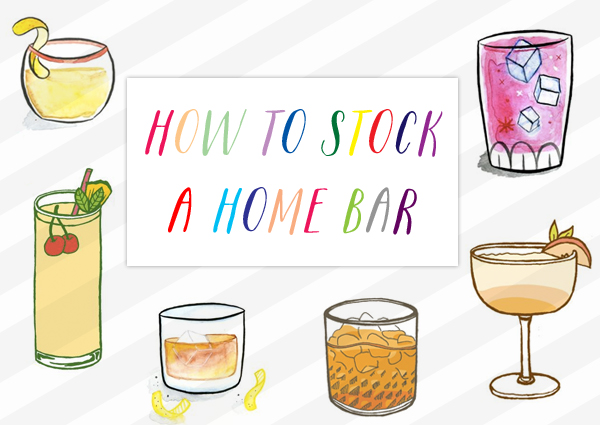
Before we get going, here are some principles:
1. Every bar is different. Â You should stock yours the way you will be drinking, not based on how someone else thinks you should stock your bar. Â Do you like to host cocktail parties? Have a big bar. Like to explore obscure, complex pre-Prohibition cocktails? Have a diverse bar. Occasional drinker? Keep it small. You get the idea.
2. A bar is never really fully complete. There are simply too many spirits out there, too many distilleries and too many varieties, too many mixers, to ever really be finished. So resist the urge to have one of everything. I use a one-in, one-out rule to keep our house from being overrun and our wallets emptied.
3. Don’t be afraid to try new things and experiment. It’s ok to have favorites, but as bottles are emptied and need replacing, consider trying a new distillery, a new variety, or even a totally different spirit.
4. Finally, you can make an amazing variety of delicious drinks with a fairly small handful of spirits and mixers. If you start out (or stay) small, don’t worry about missing out. It’s easy to fall down the rabbit hole of trying every obscure liqueur, but then you run the risk of a bar stocked with nothing but random bottles that you’ll never finish drinking, instead of focusing on some basic but delicious cocktails.
Ok, onto our bar.
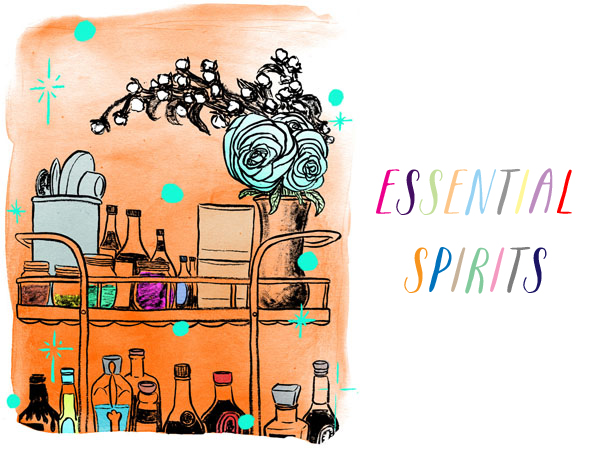
First, what I consider essential spirits for our home bar:
I like to have at least a couple varieties of Whiskey around, usually a sweeter Bourbon and a spicier Rye on hand at all times. Bulleit is one of my favorite distillers around for both. Maker’s Mark is also one of the best bourbons out there, and Old Overholt makes a great and surprisingly cheap rye.  I also love having a bottle of Scotch whiskey on hand, but for some reason I find it difficult to keep one around for long….
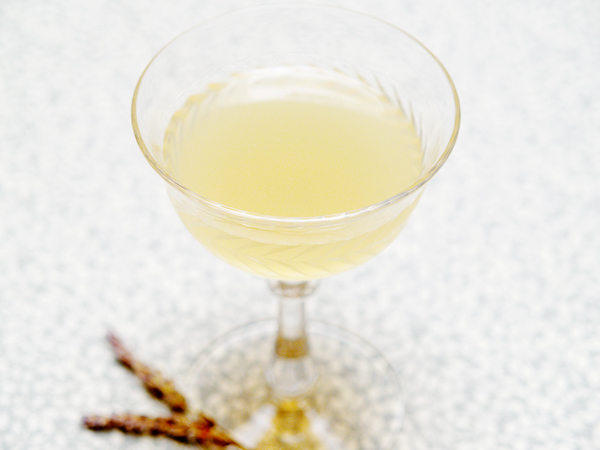
I always keep at least one English Dry Gin on hand, and at least one more gin, either a softer Old Tom Gin or a malty Genever. Plymouth and Hendrick’s are two of our favorite dry gins. Bols makes my favorite Genever, though I confess that I have only tried a few, and most are not exported to the United States.
I like to always have on hand at least two kinds of Rum. The first is a smooth Plantation-style aged rum. St. Lucia’s Chairman’s Reserve and Nicaragua’s Flor de Caña are two of my favorite, affordable rums, and Gosling’s Black Seal is essential for anyone making a Dark and Stormy. The second is a funky, pirate-style rum, like a Brazilian Cachaça or a Rhum Agricole, but I’m just beginning to explore different distillers here.
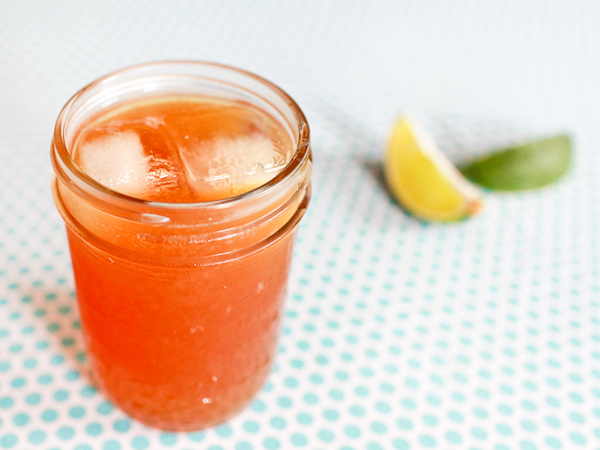
I like to keep at least one Tequila and usually two on hand at all times: a smoother aged Reposado or Añejo Tequila and a smokey Mezcal.  I confess not to know much about Mexican distillers of these spirits, but I do know to look for 100% Agave spirits only.
I always have at least one bottle of Brandy on hand.  Every once in a while I’ll splurge on a fancy bottle of French Cognac, but most of the time I stock either a much cheaper American-distilled brandy or, even better, an Apple Brandy or, more properly, an Apple Eau de Vie. Literally “water of life,” an Eau de Vie is a brandy made from fruit other than grapes, like apricots or pears. I’m a big fan of Oregon’s Clear Creek Apple Brandy or a sharper, wilder French Calvados.
Next, what I consider to be essential accompaniments to these spirits:
Liqueurs: The one liqueur that I consider absolutely essential to have around is a good Triple Sec, a bitter orange liqueur, because of its enormous versatility. Our personal favorite is Cointreau. For many of the classic, pre-Prohibition cocktails I love, I also like to make sure we always have a Maraschino liqueur, like Luxardo’s, and for some of the more interesting drinks out there, I like to make sure we have a French herbal liqueur like Benedictine or Chartreuse, and an Italian amaro, like the fiercely bitter Campari or the sweeter, orange-flavored Aperol. And, while it’s easy to get overwhelmed by the enormous diversity of liqueurs available to you, we always make sure to keep on hand a bottle of Nole’s favorite, St-Germain.
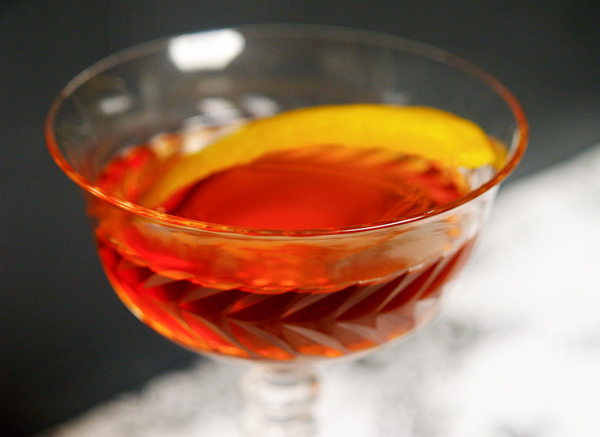
Bitters: The most basic home bar can probably get away with a single bottle of bitters, either Angostura or Orange bitters, like the spicy Regan’s Orange Bitters. I like to have both, plus a bottle of Peychaud’s , essential for lots of classic cocktails, like the Sazerac, on hand all the time. Bitters are a must-have, like salt and pepper, the essential seasonings of cocktails: they add flavors of their own and they enhance or highlight flavors from other ingredients.
Vermouth: We keep a bottle of Sweet Vermouth and a bottle of Dry Vermouth – also known as, respectively, Red or Italian Vermouth and White or French Vermouth. Vermouth is a fortified wine, flavored with a variety of herbs and botanicals, and is critical for basic drinks like the Manhattan and the Martini. I’m an unabashed fan of Dolin Vermouth.
Mixers: I try to keep on hand lots of fresh citrus fruit for juicing and zesting, along with soda and tonic water and ginger beer. As for the latter, I’m a big fan of Fever Tree, which purports to use high quality natural ingredients.
Got all that? Good. Here are some things to consider once you have your basics down:
Absinthe isn’t for everyone, and while I think it’s an essential, I’m including it down here because of its hard-to-love licorice flavor. Absinthe is necessary for many classic drinks like the aforementioned Sazerac, and really helps improve many others, but you can probably live without a bottle and still make lots of great cocktails. Consider an Absinthe Verte, like Leopold Brothers, that goes easier on the anise.
Once you have a solid set of basic spirits, consider having on hand some of the more obscure: a Scandinavian Akavit (or Aquavit), like gin but flavored with rye and cardamom instead of juniper. Or a funky South American Pisco brandy. Or variations on some of the basics: a mellow Canadian Club or Irish Whiskey, a smooth Wheated Bourbon whiskey, or a complex Aged Old Tom Gin. Just don’t overpay for a bottle of unaged White Whiskey, which is essentially a bottle of Moonshine, and should not cost the $40 or more that distillers have discovered they can charge.
Go wild with your bitters. Â Two of my favorites, neither of which is essential but which are fun to have around, are a bottle of Fee Brothers Black Walnut Bitters and a bottle of Bitter Truth Chocolate Bitters. Â As part of our broader drinking renaissance, there has been an explosion in bitters diversity in the last few years, so you’ll never run out of options.
Experiment with your liqueurs, but go a little less wild.  Bitters bottles are small and cheap and easy to collect; liqueurs are bigger and can often be pretty expensive, and you run the risk of overwhelming your bar with very specific flavors that you only use occasionally. Don’t get me wrong: there are many great liqueurs out there, and some – like Creme de Violette – are essential to some fantastic old drinks.
Once you have mastered Vermouth consider some of the more advanced fortified apertif wines, like Cocchi Americano or Punt e Mes.
Whew! Still reading? Good! Two final thoughts:
- Even though this post has gotten ridiculously long, I have almost certainly forgotten something. Â Like I said, every bar is a work in progress, and there’s no wrong way to stock one.
- One thing you might have noticed missing: Vodka.  I’ve said it before and I’ll say it again: no vodka in our bar!  To be sold as vodka, by U.S. law, a spirit must be flavorless and odorless. In other words, vodka provides alcohol – to get you drunk – without any of the flavors that make other spirits a culinary experience, not just a drinking experience. Just as I would refuse a tasteless, odorless steak, I won’t stock vodka.
And there you have it! That’s how I stock our home bar. For everyone who hasn’t started: get shopping! For everyone who has, tell us how you stock yours!

As a Nicaraguan gal, I’m happy to see you mention Flor de Caña as one of your favorite rums! Great post!
LOVE these cocktail posts. Excited to add these bar-stocking suggestions to our mini-bar at home.
whew… so much information! i know this post (and your home bar) was a labor of love to put together. thanks for sharing!!!